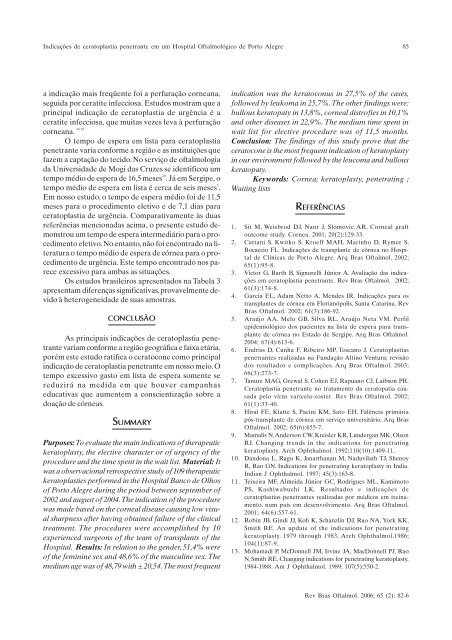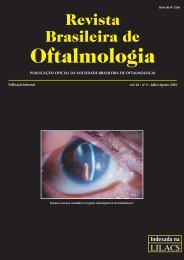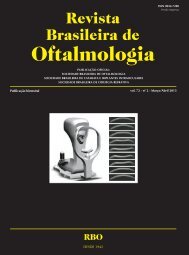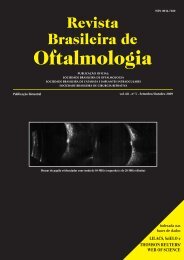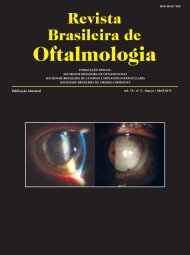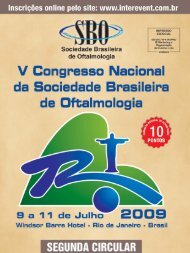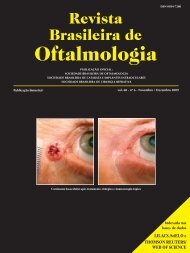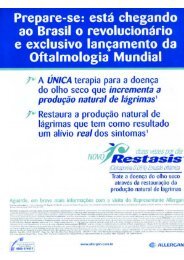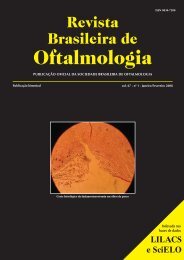Mar-Abr - Sociedade Brasileira de Oftalmologia
Mar-Abr - Sociedade Brasileira de Oftalmologia
Mar-Abr - Sociedade Brasileira de Oftalmologia
Create successful ePaper yourself
Turn your PDF publications into a flip-book with our unique Google optimized e-Paper software.
Indicações <strong>de</strong> ceratoplastia penetrante em um Hospital Oftalmológico <strong>de</strong> Porto Alegre<br />
85<br />
a indicação mais freqüente foi a perfuração corneana,<br />
seguida por ceratite infecciosa. Estudos mostram que a<br />
principal indicação <strong>de</strong> ceratoplastia <strong>de</strong> urgência é a<br />
ceratite infecciosa, que muitas vezes leva à perfuração<br />
corneana. 16-19<br />
O tempo <strong>de</strong> espera em lista para ceratoplastia<br />
penetrante varia conforme a região e as instituições que<br />
fazem a captação do tecido. No serviço <strong>de</strong> oftalmologia<br />
da Universida<strong>de</strong> <strong>de</strong> Mogi das Cruzes se i<strong>de</strong>ntificou um<br />
tempo médio <strong>de</strong> espera <strong>de</strong> 16,5 meses 20 . Já em Sergipe, o<br />
tempo médio <strong>de</strong> espera em lista é cerca <strong>de</strong> seis meses 5 .<br />
Em nosso estudo, o tempo <strong>de</strong> espera médio foi <strong>de</strong> 11,5<br />
meses para o procedimento eletivo e <strong>de</strong> 7,1 dias para<br />
ceratoplastia <strong>de</strong> urgência. Comparativamente às duas<br />
referências mencionadas acima, o presente estudo <strong>de</strong>monstrou<br />
um tempo <strong>de</strong> espera intermediário para o procedimento<br />
eletivo. No entanto, não foi encontrado na literatura<br />
o tempo médio <strong>de</strong> espera <strong>de</strong> córnea para o procedimento<br />
<strong>de</strong> urgência. Este tempo encontrado nos parece<br />
excessivo para ambas as situações.<br />
Os estudos brasileiros apresentados na Tabela 3<br />
apresentam diferenças significativas, provavelmente <strong>de</strong>vido<br />
à heterogeneida<strong>de</strong> <strong>de</strong> suas amostras.<br />
CONCLUSÃO<br />
As principais indicações <strong>de</strong> ceratoplastia penetrante<br />
variam conforme a região geográfica e faixa etária,<br />
porém este estudo ratifica o ceratocone como principal<br />
indicação <strong>de</strong> ceratoplastia penetrante em nosso meio. O<br />
tempo excessivo gasto em lista <strong>de</strong> espera somente se<br />
reduzirá na medida em que houver campanhas<br />
educativas que aumentem a conscientização sobre a<br />
doação <strong>de</strong> córneas.<br />
SUMMARY<br />
Purposes: To evaluate the main indications of therapeutic<br />
keratoplasty, the elective character or of urgency of the<br />
procedure and the time spent in the wait list. Material: It<br />
was a observacional retrospective study of 109 therapeutic<br />
keratoplasties performed in the Hospital Banco <strong>de</strong> Olhos<br />
of Porto Alegre during the period between september of<br />
2002 and august of 2004.The indication of the procedure<br />
was ma<strong>de</strong> based on the corneal disease causing low visual<br />
sharpness after having obtained failure of the clinical<br />
treatment. The procedures were accomplished by 10<br />
experienced surgeons of the team of transplants of the<br />
Hospital. Results: In relation to the gen<strong>de</strong>r, 51,4% were<br />
of the feminine sex and 48,6% of the masculine sex.The<br />
medium age was of 48,79 with ± 20,54.The most frequent<br />
indication was the keratoconus in 27,5% of the cases,<br />
followed by leukoma in 25,7%. The other findings were:<br />
bullous keratopaty in 13,8%, corneal distrofies in 10,1%<br />
and other diseases in 22,9%. The medium time spent in<br />
wait list for elective procedure was of 11,5 months.<br />
Conclusion: The findings of this study prove that the<br />
ceratocone is the most frequent indication of keratoplasty<br />
in our environment followed by the leucoma and bullous<br />
keratopaty.<br />
Keywords: Cornea; keratoplasty, penetrating ;<br />
Waiting lists<br />
REFERÊNCIAS<br />
1. Sit M, Weisbrod DJ, Naor J, Slomovic AR. Corneal graft<br />
outcome study. Cornea. 2001; 20(2):129-33.<br />
2. Cattani S, Kwitko S, Kroeff MAH, <strong>Mar</strong>inho D, Rymer S,<br />
Bocaccio FL. Indicações <strong>de</strong> transplante <strong>de</strong> córnea no Hospital<br />
<strong>de</strong> Clínicas <strong>de</strong> Porto Alegre. Arq Bras Oftalmol. 2002;<br />
65(1):95-8.<br />
3. Victor G, Barth B, Signorelli Júnior A. Avaliação das indicações<br />
em ceratoplastia penetrante. Rev Bras Oftalmol. 2002;<br />
61(3):174-8.<br />
4. Garcia EL, Adam Netto A, Men<strong>de</strong>s IR. Indicações para os<br />
transplantes <strong>de</strong> córnea em Florianópolis, Santa Catarina. Rev<br />
Bras Oftalmol. 2002; 61(3):186-92.<br />
5. Araújo AA, Melo GB, Silva RL, Araújo Neta VM. Perfil<br />
epi<strong>de</strong>miológico dos pacientes na lista <strong>de</strong> espera para transplante<br />
<strong>de</strong> córnea no Estado <strong>de</strong> Sergipe. Arq Bras Oftalmol.<br />
2004; 67(4):613-6.<br />
6. Endriss D, Cunha F, Ribeiro MP, Toscano J. Ceratoplastias<br />
penetrantes realizadas na Fundação Altino Ventura: revisão<br />
dos resultados e complicações. Arq Bras Oftalmol. 2003;<br />
66(3):273-7.<br />
7. Tanure MAG, Grewal S, Cohen EJ, Rapuano CJ, Laibson PR.<br />
Ceratoplastia penetrante no tratamento da ceratopatia causada<br />
pelo vírus varicela-zoster. Rev Bras Oftalmol. 2002;<br />
61(1):33-40.<br />
8. Hirai FE, Klatte S, Pacini KM, Sato EH. Falência primária<br />
pós-transplante <strong>de</strong> córnea em serviço universitário. Arq Bras<br />
Oftalmol. 2002; 65(6):655-7.<br />
9. Mamalis N, An<strong>de</strong>rson CW, Kreisler KR, Lun<strong>de</strong>rgan MK, Olson<br />
RJ. Changing trends in the indications for penetrating<br />
keratoplasty. Arch Ophthalmol. 1992;110(10):1409-11.<br />
10. Dandona L, Ragu K, Janarthanan M, Naduvilath TJ, Shenoy<br />
R, Rao GN. Indications for penetrating keratoplasty in India.<br />
Indian J Ophthalmol. 1997; 45(3):163-8.<br />
11. Teixeira MF, Almeida Júnior GC, Rodrigues ML, Kamimoto<br />
PS, Kashiwabuchi LK. Resultados e indicações <strong>de</strong><br />
ceratoplastias penetrantes realizadas por médicos em treinamento,<br />
num país em <strong>de</strong>senvolvimento. Arq Bras Oftalmol.<br />
2001; 64(6):557-61.<br />
12. Robin JB, Gindi JJ, Koh K, Schanzlin DJ, Rao NA, York KK,<br />
Smith RE. An update of the indications for penetrating<br />
keratoplasty. 1979 through 1983. Arch Ophthalmol.1986;<br />
104(1):87-9.<br />
13. Mohamadi P, McDonnell JM, Irvine JA, MacDonnell PJ, Rao<br />
N, Smith RE. Changing indications for penetrating keratoplasty,<br />
1984-1988. Am J Ophthalmol. 1989; 107(5):550-2.<br />
Rev Bras Oftalmol. 2006; 65 (2): 82-6


